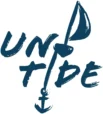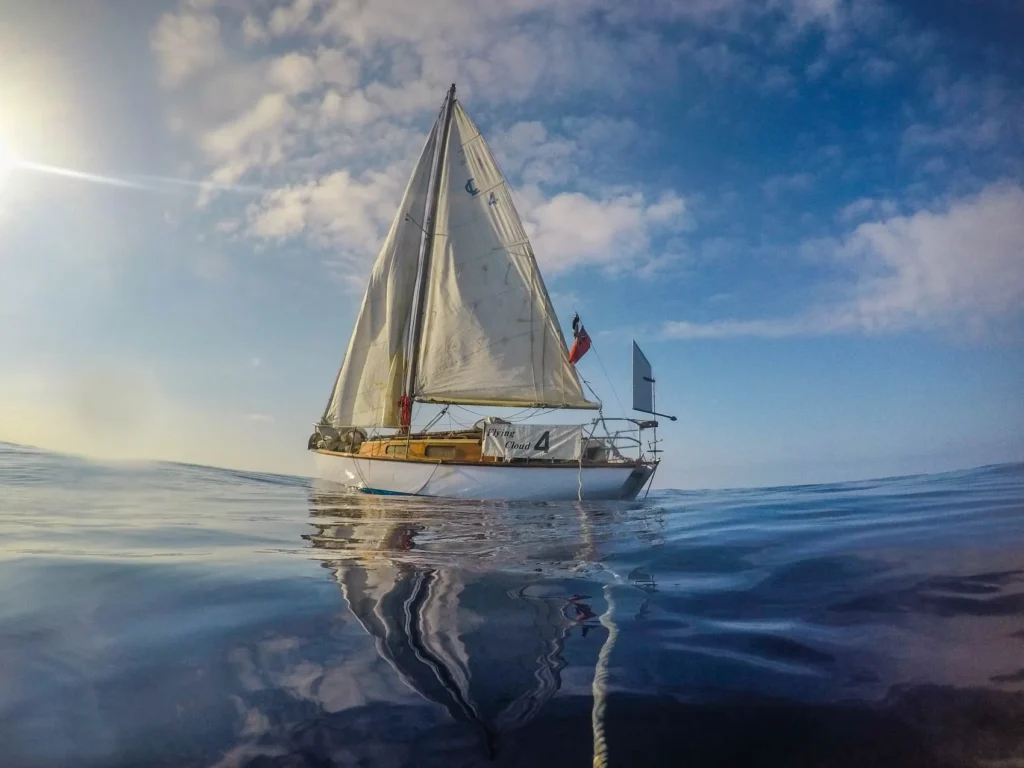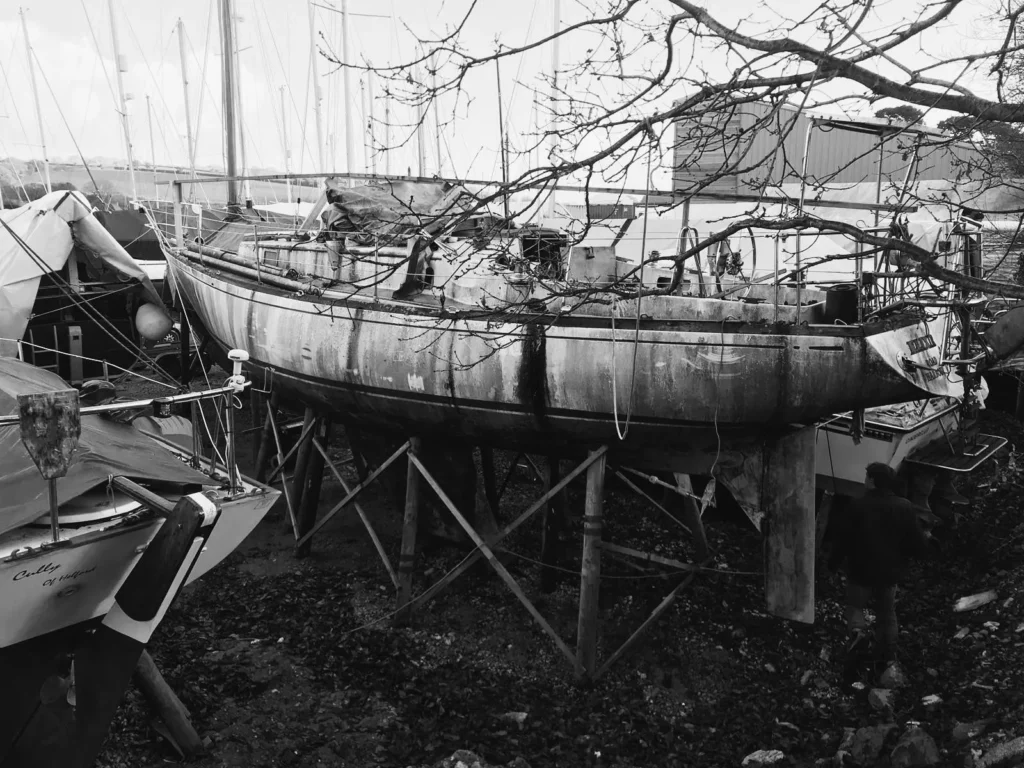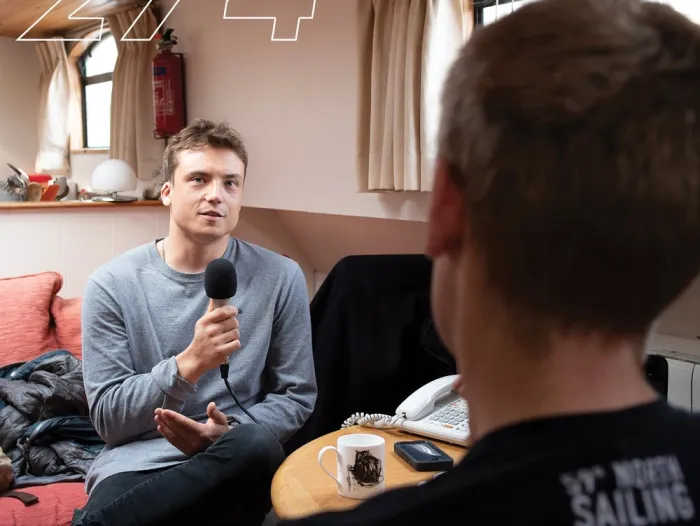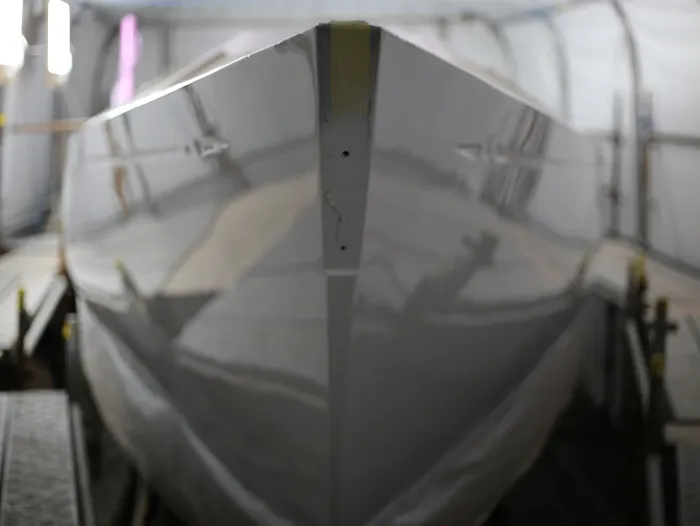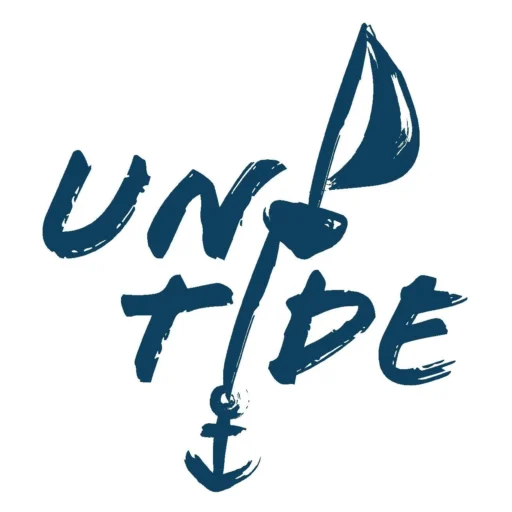La Graciosa
The Calima caught us with our pants down. A violent gust, whistling through the rigging, wakes me at 4 am. I hate to get out of bed at night and I especially hate having to go outside in my pajamas. Emerging from the companionway is like stepping into another world. I feel assaulted, as if the wind is simultaneously shaking my shoulders and screaming into my face. I notice the wave riplets breaking as I shuffle along the side deck. Only the anchor matters now. The lifeline which ties Elixir to the seabed, the only real insurance a boat can have.

We’re anchored in five meters of water, above a sandy bottom, and in theory the holding should be good. My anxiety wouldn’t be so bad, if it wasn’t for the lee shore that I knew lurked in the darkness like some hidden predator. If the anchor was to fail, it would be less than a minute before Elixir would be on the rocks. And that would be it — the end of the dream. I let out another 20 meters of chain and return to the warmth of my bunk.
I’m far too terrified to sleep yet attempting to move the boat in darkness is a stupid idea. Instead, I stare at the arrow on Navionics, and wait for the inevitable moment when the anchor begins to drag. I realise that the situation is mostly out of my hands. For now, all I can do is lie here, watching the little yellow arrow and listening to the demonic shriek of the building gale.
Sunrise
I notice the first signs of daylight and move to the companionway to make sense of the chaotic situation. The wind is rolling down the high cliffs of Lanzarote, two miles to the west. They are steep and curved, like the quarter-pipe at a skatepark. There is no doubt we need to move — the anxiety is unbearable.
Tied alongside the boat is our tender Ian. The gusts are powerful enough to lift the chubby little inflatable completely out of the water. Watching him leap into the air like a dog on a chain is the final straw for me, I step back inside the cabin.
‘We’ve got to go, it’s like 50 knots outside, and Ian is flying through the air on his painter’.
Escaping La Grasiosa
By 7 am everyone’s up. Breakfast is out of the question, and we get to work deflating Ian on the deck and swapping our big, lightweight genoa for a smaller, heavier sail. Weighing the anchor is hard due to the broken electric windlass, and it requires all four of us. After half an hour the anchor still isn’t in. Normally, the engine cuts out after half an hour, and I’m amazed it’s still running. I wonder if I’d have time to bleed the fuel system and get it running again before Elixir washes up on the rocks. Probably not. Why didn’t I fix the issue in Portugal? And the windlass too? My laziness has come back to bite me, I’m a terrible skipper.
It takes another ten minutes to pull the anchor up. Harry’s hands are bleeding, and I can’t think of a worse way to start the day for a lanky guy with back problems and eczema. As soon as we detach from the seabed the bow swings round, I push the throttle down and blankets of spray drench the cockpit. In the morning’s chaos, I hadn’t even thought to put on my wet weather gear, but that didn’t even matter. All I care about is getting out to sea — away from rocks and lee shores, I want as much sea room as I can get. As we make ground away from the boiling rocky shore, I recognise a familiar rhythm in the sound of the engine. The engine slows and begins to stutter, Elixir loses steerage and boat speed, then the engine cuts out.


The Storm Rig
We’ve made enough distance past the rocky headland to start sailing. We unfurl a coffee table sized section of headsail, and Elixir heels and lurches forward. We set off on a deep reach, moving fast through the water, whilst the land becomes obscured by a thick haze.
Our plan is to pull into a sheltered harbour in the south of Lanzarote. I’m worried because we will need to head up even more, and eventually beat the last two miles into the harbour. I hope that the fierce, un-forecast wind is something to do with the towering cliffs. If we sail away from them, then maybe, if we’re lucky, the wind will drop down to 30 knots. We can deal with that, but this is too much.
We reach the headland, and the wind hasn’t eased. The sea is covered with a bubbling white foam — there’s no groundswell, but the choppy wind waves still find their way on to the deck. Never have I seen spray tear off the crest of each wave like this.


One of the stronger gusts causes the mast to pant. Unfamiliar with this phenomenon, it takes me a while to understand why the whole boat is trembling. The windage on the mast is causing the entire 55’ pole to flex back and forth, causing a deep shaking that vibrates the whole boat. By tightening the running backstays, we manage to stop the worst of it.
A Change of Plan
By now, it’s obvious to me that we’re not going to make it into Lanzarote. The wind isn’t dropping, and there’s no way we’re going to be able to sail any closer to it. In my mind, I’ve already accepted that we’re going to have to change our plans. Our only choice is to run with the gale, through the night, and ultimately make landfall in Tenerife, 180 miles to the west.
One of the biggest lessons I’ve learnt from my trip in Flying Cloud, is that when sailing, always be flexible to change. Too much relies on nature — it’s inevitable that at some point you’re going to have to shift to plan B. We have enough food, cooker fuel, and water to get there. The main issue is, I know it’s going to get uncomfortable.


I tell Lily first, as we’re both inside the cabin.
‘There’s no way we’re making it into Lanzarote. We need to change our plan.’
The expression on her face is a mixture of worry and disbelief. It’s obvious, that up until this point, she hadn’t considered not making it to Lanzarote.
‘The wind is too strong; we can’t make any ground to windward. I think Tenerife is our best bet.’
We had spent the morning joking about the comforts of land that were only a few hours away. Ice cream, tapas, coffee and beers. I’ve robbed everyone of these rewards — I’d sold the idea of Lanzarote, and the fun we’d have on arrival. Now I feel like a dick, because instead of ice cream and beers, we’d be spending the night at sea, in one of the scariest storms I’ve ever seen.
Heaving too
We heave too, a clever way to park your boat in the middle of a gale. We lash the wheel, so that Elixir is steering up into the wind, and back the jib, which acts to push the front of the boat away from the wind. These two actions work against each other, and the boat finds a sort of equilibrium. Unable to head up due to the backed jib, and unable to steer down due to the lashed steering wheel.
We leave Elixir to fend for herself, slide the hatch and washboards shut, and gather in the saloon to talk about the change of plan. We all agree that Lanzarote is out of the question — we’re going to Tenerife.
Nobody speaks much after that. Lily and Harry lie in their beds, and Chloe sits in the saloon with her head buried between her knees. The motion is uncomfortable, and everything is screaming — the wind, the rig the sea. The high-pitched shriek is occasionally broken by the sound of a wave cascading over the deck.
One worry is Elixir’s tracker, which is watched closley by some very worried parents. They are not going to like watching the little red dot wander away from the closest bit of land. We let them know we’re going to Tenerife but keep it a secret that the ocean is trying to kill us.
After an hour of lying in bed, feeling sorry for ourselves, I decide to make lunch. It’s not easy, but I manage to wedge myself in the corner of the galley for long enough to make instant noodles. I’ve always found that the soupy broth gives me superpowers, and after finishing the bowl I’m eager to get back behind the wheel and start moving again.


Facing the storm
My wet weather gear is soaked through, and Lily lets me borrow hers, which is comforting as it’s still warm when I put it on. I step outside into the cockpit, to find the deck covered with orange sand. The visibility is very bad, not due to rain or mist, but because of a fine dust suspended in the air. The wind has eased enough to start sailing again. I unfurl a small bit of headsail, the size of a door, and point the boat downwind.
We take it in turns with two-hour watches. The sun sets and the wind builds again. Keeping Elixir pointing in the right direction requires a lot of attention — the sweet spot is dead downwind. A brief moment of lost concentration, and a white foaming wave will slop into the cockpit.
The night is long, and nobody sleeps that much. The dust cloud thickens, completely blocking the rising sun. It’s like a scene from a Mad Max movie, a dystopian desert seascape. It’s as if we’ve sailed into a post-apocalyptic world.


We realise that the dust has not come from Lanzarote, but from the Sahara Desert, some 200 miles to the East. We also notice an assortment of strange desert creatures, swept off the Sahara by the dust storm. A delicate green bird lands on the guard rail — it’s very social, and it lets us stroke it. It’s clear this vibrant bird doesn’t belong at sea, and is probably wondering how it ended up hundreds of miles away from land. We also see moths and beetles, and a series of dragonflies cling to the backstay.
Post-apocalyptic scenes
The surreal ochre light deepens, and the wind drops to a moderate breeze. I set the mainsail, and we take off on a broad reach. The dust has made the sheets and sails stiff, and I struggle to get the lines to turn around the winches. On a port tack, we thread the narrow channel between Gran Canaria and Tenerife. The wind builds and dies as we pass in and out of acceleration zones. Crossing the shipping lane is terrifying, especially without AIS. I send a radar deflector up on a halyard, and hope that any beasts lurking in the darkness are paying as much attention as we are.


We loop around the South East tip of Tenerife and start pondering a landfall. The lack of visibility is terrifying, on top of that, it’s still quite windy. I’m not convinced that the engine will start at all.
I choose the closest harbour, so we can get out of this scary situation as soon as possible. We’re within two miles of land now, and we still can’t see Tenerife. No lights or shadows, the only signs are the flat water and warm dry air.


Teneriffe
Within a mile of the harbour entrance, we make out a faint glow behind the haze. It’s hard to tell what it is — it’s red, but doesn’t look like a navigation light. As we sail closer, I manage to identify the harbour entrance, but still can’t quite understand the glaring red light in front of me. We realise that it’s a bar — it’s deserted, but the lights are still on.
I’m relieved that the engine starts. We loop round the edge of the breakwater and the marina opens in front of us. It’s full of yachts piled next to each other like a messy bookshelf. Gusts whistle down from the hills causing each boat to heave on its mooring lines. I pray that the engine won’t cut out.
There’s no obvious place to park the boat, so we venture deeper within the pontoons. It doesn’t look open to visitors. Groups of people are sat out in their cockpits, intoxicated, and speaking a language that I couldn’t identify. We get to the back of the marina and realise that there is no space for Elixir, we will have to turn around and go back. I’m still new to maneuvering in confined spaces. The windage on the mast makes it harder, and having an engine that threatens to cut out at any moment adds to the anxiety.


A close call
I commit to a three-point turn between two pontoons, packed with expensive looking fiberglass yachts. The bow comes very close to another boat, and the engine threatens to cut out. Thankfully it doesn’t, and I manage to reverse away from the expensive piece of plastic.
But then the engine stops! We stare at each other in the silence — we’re powerless, at the mercy of the wind and being driven towards the crowded pontoon. The situation is almost comical. Here we are, covered in dust on an freshly painted boat, heading towards an imminent crash with a raft of expensive looking yachts.
Harry dashes down the companionway and pulls off the side of the engine box. To start her up again, he needs to use the hand pump, and bleed diesel back to the injector. I turn the key and the engine whirrs, sucking air through the pipe like a straw in an empty glass. I’m sobered by the closeness of everything, and mentally preparing myself to use my hand to push away from the closest boat.
The engine coughs on a droplet of diesel. Then it fires a few more times before shuddering into life, giving us the motion we need to remove ourselves from the tense situation. We find a place to park near the mouth of the harbour, and never have I been so relieved to set foot on a pontoon.
A Stranger
Shortly after tying off the mooring lines, a stern-faced man cuts down the pontoon making stiff eye contact with me. I’m sure he is about to tell us to fuck off. There’s no place for broke, greasy sea gypsies in a marina like this. The last two days have been too emotional, the thought of a confrontation makes me want to cry.
‘Where have you come from?’
I have spent time in St. Petersburg and recognized the Russian accent immediately.
‘La Graciosa’, I replied.
‘Through the storm?’, he looked surprised.
‘Yeah’.
He cast a glance over Elixir, drenched in orange dust, before turning his back on us and walking back down the pontoon.
A few minutes later he returned with a bottle of vodka in his hand.
‘Here, you’ll need this for your nerves’.
.
.
Watch the video of our eventful encounter with the Calima here.
